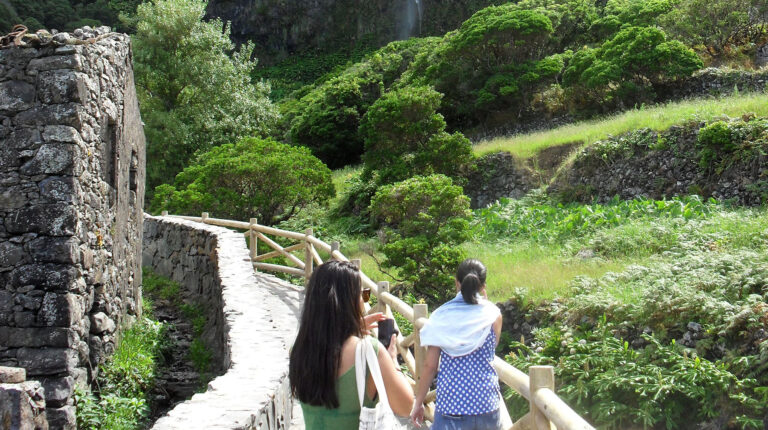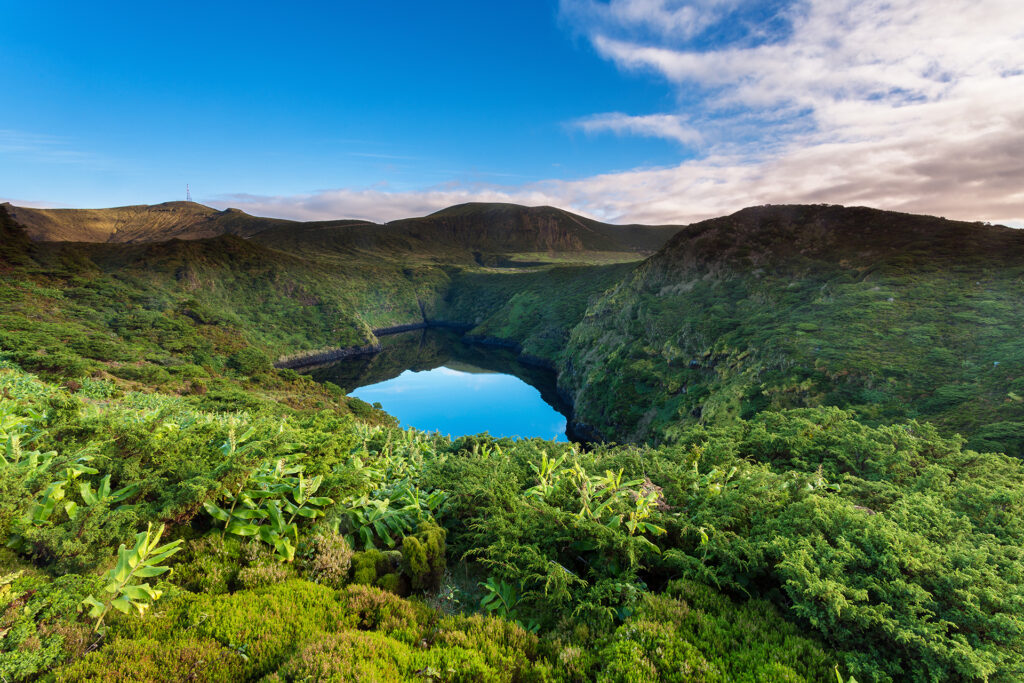About Flores
The Azores
Known for its natural beauty and awarded in categories such as Sustainable Tourism or Adventure Tourism, the 9 islands of the Azores make up an archipelago of unique beauty, which has charmed both its visitors and locals for centuries.
Officially designated as The Autonomous Region of the Azores, this is a transcontinental archipelago of volcanic nature, as well as an autonomous territory of the Portuguese Republic, endowed with political and administrative autonomy, located in the Northeast Atlantic.
From a geographical point of view, the islands can be divided into three groups: the western group, consisting of the islands of Corvo and Flores; the central group, formed by the islands of Graciosa, Terceira, São Jorge, Faial and Pico; and finally, the eastern group, composed of the islands of São Miguel and Santa Maria. Its current population (2021 data) stands at approximately 236,657.

Ready for a unique adventure?
If you are curious about the history, culture, or other facts about Flores, you can find some information here that can help you learn a little more.
Official language: Portuguese Religion: Catholic Official Currency: Euro (€)
Geography
With a length of 16.6 km, a width of 12.2 km, and covering an area of 141.4 km², this piece of land, inhabited by 3,429 people (2021 data) marks the westernmost point of the European continent. Flores Island belongs to the Western Group of the archipelago, along with the island of Corvo, which is located 17.9 km away. The highest point on the island, Morro Alto, reaches an elevation of 911 metres.
Climate
Located in the middle of the Atlantic Ocean, in the centre of the Azores’ high-pressure zone, and surrounded by the warm Gulf Stream, Flores enjoys a temperate maritime climate with minimal temperature fluctuations and an average annual temperature of 24°Celsius. There are frequent showers followed by periods of sunshine, particularly between October and April.
The island was discovered by the Portuguese around 1452, by Diogo de Teive and his son. In 1470, Willem van de Haegen, a Flemish nobleman, initiated a settlement experiment in Vale da Ribeira da Cruz.
However, the island’s remoteness and the lack of regular boat connections, which would have allowed for the export of dyer’s woad to Flanders, led him to abandon the island a few years later. Under the guidance of the Donatary Captain João da Fonseca from Évora, the settlement of the island with colonists from the mainland resumed after 1504. Many of these colonists came from Terceira, while some from Madeira. In 1515, Lajes became a town, and in 1548, Santa Cruz followed suit. By the late 1500s, Ponta Delgada, situated to the north, had also been established as a parish.
The airport and modern port facilities played a pivotal role in breaking Flores’ isolation, aligning with the progress of the Azores. Currently, agriculture, livestock farming, and dairy production are the island’s economic pillars, along with Tourism.
The Emigrant Festival pays tribute to the people of Flores who left in search of better opportunities, but never fail to return to their homeland every year. This festive celebration, a place of reunion for old friends, marks the island’s calendar during the month of July.
A little earlier, on the 24th of June, Saint John’s Day is celebrated. The devotion to the patron saint dates back to the settlers from Terceira and has remained strong throughout the centuries. As in the rest of the archipelago, the Holy Spirit Festivities take place from May to September, and this devotion takes on a particularly colourful atmosphere in Santa Cruz, with flower arches adorning the streets.
In August, during the Cais das Poças Festival in Santa Cruz das Flores, the village comes even more to life with nighttime entertainment and popular festivities.
Handicraft, more than any other testimony, embodies the richness of a heritage, vast and brimming with points of interest, where it reflects the unique characteristics of its people: their inventive spirit, innate manual skills, refined aesthetic sense, a natural assimilation of the surrounding geographic environment, and a strong, distinctive character.
The Azores are also renowned for their traditional bobbin lace, meticulously handwoven by skilled lace-makers. Another distinctive form of handicraft is the production of wicker and cedar baskets, traditionally used for transporting food, agricultural products, and fish — a skill passed down through generations.
On the island of Flores, basalt nativity scenes are very common, carved from volcanic stone, an iconic representation of the archipelago. Basalt is abundant in these volcanic islands and has been used for centuries in various artistic and architectural pieces, with a particular focus on the creation of nativity scenes with intricate details.

Craters, lagoons, streams, and waterfalls define the landscape of the island. The water from the streams flows calmly across the surface of the central plateau or rushes swiftly down waterfalls and along extensive, deep valleys. The island features seven volcanic craters that have turned into enchanting lagoons. Abundant vegetation and clusters of flowers blooming on the slopes complete the surrounding natural scenery. Notable landmarks include Rocha dos Bordões and the islet of Monchique, marking the westernmost point of the European continent. This black rock marks the end of Europe and represents a prelude to the discovery of an island and an archipelago. The area from Fajã Grande to Fajãzinha is one of the most beautiful coastal landscapes in the Azores, with around twenty impressive waterfalls, particularly the Ribeira Grande waterfall, which cascades in a 300-metre drop.
For centuries, the islands of the western group remained somewhat isolated due to their distance from the rest of the archipelago. As a result, the inhabitants learned to rely on local production as the basis for their diet.
During the winter, when it was difficult to go out to sea for fishing, pork often served as sustenance. The dish “cozinhada de porco” (boiled pork) has stood as a testament to those times: pork meats are brined, then after soaking, they are boiled and served with potatoes and cabbage. Yam with smoked sausage and watercress soup complement the more traditional menu of Flores.
The surrounding sea is bountiful and serves as an inspiration for the Florentine cuisine. In dishes like “tortas de erva patinha” the concept of omelettes is combined with the seaweed that grows along the coast. Fish, a crucial part of the island’s traditional gastronomic heritage, is featured in various recipes, such as the oven-roasted albacore and conger stew.
The island of Flores is an ideal destination for nature lovers and outdoor sports enthusiasts. It boasts breathtaking landscapes and rich biodiversity.
Among all the islands, Flores offers the best conditions for canyoning, involving waterfalls, streams, and cliffs. With experienced guides, participants have the opportunity to explore locations that are otherwise inaccessible. Crystal-clear waters, natural pools, plunging waterfalls, lagoons, and cliffs are some of the sights you can see while canyoning.
In addition to canyoning, the island of Flores offers other sports activities such as hiking, cycling, fishing, stand-up paddle, canoeing, and more. These activities will make your trip to this destination with its unique and untouched natural beauty.


Health Centres:
Due to the size of Flores Island, there is only one health centre to provide emergency services; in serious cases users are referred to Horta’s Hospital in Faial Island or Hospital do Santo Espírito in Terceira Island.
Santa Cruz das Flores: +351 292 590 270
Emergency number: 112
Emergency Service for Deaf Citizens: you can call the Civil Protection emergency services, via Skype video call, to SERViiN – LGP INTÉRPRETE or via the number 12472. The Portuguese Sign Language interpreter will communicate with the desired emergency service. This service is available from Monday to Friday, from 7:00 am to 10:00 pm, including holidays.
APP PROCIV Azores: The application provides information on the main self-protection measures for situations involving a risk of fire, earthquakes, storms, technological incidents or others; discloses alerts with regard to weather warnings and seismological communications, assists in first aid for victims of accidents and poisoning.
Regarding calls to 112, the application, in addition to allowing the call to be made according to the type of distress call (accident, sudden illness or others), automatically sends an email with the data you have filled in your profile, directly to the Medical Emergency Line, so that you can help you more quickly and effectively.
Civil Protection provides brochures with self-protection measures (MAP) and/or information relevant to the population and visitors. Click on the link below and access the documents that you can consult or download.
Public Security Police:
Lajes das Flores: +351 292 593 186








